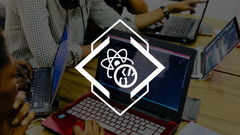Building a Blog in React
So, we now have the ability to open and close our modal, so we have the behavior we're looking for, but the look and feel isn't exactly what I had in mind, and probably not for you, either.
We're just about done with all of the functionality needed for the modal and we're about to be able to work on the blog form itself.
With our modal complete, we're now ready to start integrating the form. Now this blog form is going to be completely separate in regards to functionality from the modal itself.
Now that we have our form rendering in the modal, in this guide we're gonna write out all of the boilerplate code needed for a couple things.
In this guide, we are going to make it possible to create a blog record from our blog from and we are only going to be passing these two values, the Title and the Blog status for now but that's all we need in order to build out our API connection.
Now that we can create records using our blog form with the API what I'd like to do now is build out the entire workflow.
As promised, in this guide, we are gonna focus on a few design elements.
This is gonna be a fun guide, in this guide we're gonna take our little link here that opens up the modal and we're gonna turn it into a large clickable icon and this is something that you may have seen a similar design for in many different sites.
In this guide, we are gonna see how we can add some authorization rules for creating new blogs.
I mentioned earlier how I really was not a fan of the way that we have our icons structured. They're completely functional, they work.
It's time to start building in our Rich Text Media Editor.
In this lesson, we are going to create a rich text editor, we're gonna call the key dependencies, and then we're going to apply the initial styles.
Now that we have our blog form, all ready to receive our editor's state changes, let's see how we can wire that up and all of the functionality we're gonna have to build in order to make our rich text editor give us that string back.
As you may or may not have noticed, we are running into a warning whenever we create a new blog. And in this guide, we're gonna see what that warning is, what's causing it, and then also how to fix it.
Now that our rich text editor is working, I think it's time for us to start actually working with the HTML that it gives us.
Now that we have the libraries we need, in order to take a string that has HTML in it and convert it and render it onto the screen, let's implement that in our data detail page. And we're also going to clean it up a little bit and fix some of the bugs that you can currently see in there.
Now that we have our HTML rendering properly in our blog detail page, it's time to take a look at the index page and see what we need to do.
Now that we have our script tags and our truncate libraries imported into the application, in this guide we are going to implement them, so this is gonna build out our summaries and also pull out all of those HTML tags so that this looks nice and clean.
Up until this point, if we wanted to upload a featured image for our blog, we had to go through DevCamp Space. So in this guide, we're gonna start the process of adding our dropzone image component so that we can start adding images directly to our blog.
